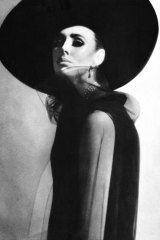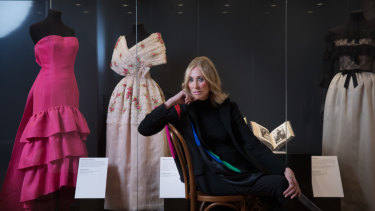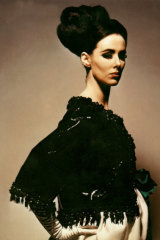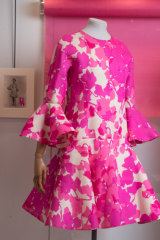Maggi Eckardt modelling for Balenciaga in the 1960s.
Maggi Eckardt's story reads like a mid-century fairy tale. Bullied as a student at her Sydney high school in the 1950s, the fashion lover begged her father to let her quit her studies to pursue modelling, first for the Queen's couturier and, ultimately, for French luxury house Balenciaga.
"I had no choice, I had to leave Australia, I had to be free. I was bullied [at school] … we didn't have as much as the other girls [at my school]. I used to come home and … I started looking at the magazines and decided from the age of 10 I wanted to be a model."
As a lonely teenager, Ms Eckardt would make her own clothes and said her father "took a real gamble" by allowing her to join a modelling agency, where she did a host of "terrible" jobs including an advertisement for an ironing board.
After learning that the Queen's couturier was in Sydney looking for models, Ms Eckardt auditioned and, in her own "Cinderella moment", she was the only girl who fit the clothes. After doing parades in Sydney, she was promised a job in London, if she could fund the passage.
Ms Eckardt left Sydney, first for London, where she worked for a few years doing catwalk, then Paris, where she worked as a photographic model, ending up at the house of Balenciaga in the early 1960s.
Still striking a pose … Maggi Eckardt, who modelled for Balenciaga in the 1960s at the exhibition that opens on Saturday at Bendigo Art Gallery.Credit:Simon Schluter
"I sailed out of Sydney Harbour with a big suitcase of homemade clothes, with no contract and no money and a one-way ticket … so that was determination," she said. "My father gave me my wings to fly. Everything I did was to prove to him he made the right choice for me."
Now in her eighties, Sydney-based Eckardt on Friday helped launch an exhibition on the history of Balenciaga and its influence on modern fashion at Bendigo Art Gallery.
The exhibition, the fourth collaboration with London's Victoria & Albert Museum, includes more than 100 pieces from the early years under Cristobal Balenciaga, dubbed "The Master" by his contemporaries, until the modern day.
Maggi Eckardt was discovered in Sydney and went on to work in London and Paris.
"I'm in tears almost, especially when you look at the film [in the exhibition]," Ms Eckardt said. "To see those garments in movement [again] is so different. Statically, they are gorgeous, but to see them moving, that was [Cristobal Balenciaga's] trick."
Stephanie Wood, project curator at the Victoria & Albert Museum, said the exhibition laid out Balenciaga's significance in 20th century fashion history, including through special X-ray photos showing the "hidden secrets" of some of its most iconic designs.
Today, under creative director Demna Gvasalia, the brand has taken a much more "street" approach to fashion, including a cult following for its bags and shoes, including sneakers.
Ms Wood said that while some of Gvasalia's designs stray far from the DNA of the house, such as a collaboration with Crocs, he also regularly pays homage to the founder's aesthetic.
"It shows how much he is respecting where the brand is from to build the future. [Cristobal Balenciaga] would enjoy that Demna is leading fashion and making Balenciaga a name [again]," she said.
There are more than 100 pieces in the exhibition.Credit:Simon Schluter
Bendigo Art Gallery director Jessica Bridgfoot said Balenciaga set the pace for modern fashion, and was a "trailblazing feminist" because of his penchant for looser cuts.
"It was said you didn't have to [have the perfect figure] to wear a Balenciaga dress … he had a way of making women feel interesting and unique without necessarily being traditionally 'beautiful'," she said.
Balenciaga: Shaping Fashion is on at Bendigo Art Gallery until November 10.
Source: Read Full Article



